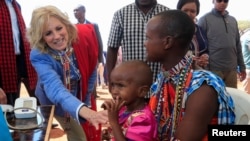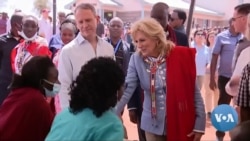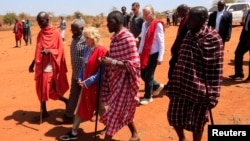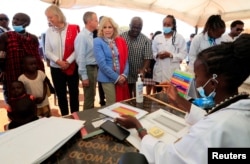U.S. first lady Jill Biden made a high-profile visit to a tiny Kenyan community to draw attention to the severe drought that has gripped East Africa and created an unprecedented food insecurity crisis in Kenya.
The United States has provided the lion’s share of humanitarian aid to East Africa after rains failed here for a third straight year, causing unprecedented hunger that stretches from Somalia to this dusty Maasai village just three hours from Kenya’s capital, Nairobi.
The U.N. chief for Kenya told VOA that 6 million people are on the brink of extreme hunger this year and that the situation is exacerbated by the food-supply crisis caused by the conflict in Ukraine.
But the world’s richest nation can’t walk this road alone, Biden said after her visit to the Maasai village which is suffering the worst drought seen in this area in seven generations. The trip came at the end of a five-day visit that took her to Kenya and the Southwest African nation of Namibia.
“The United States is providing 70% of the budget, the money, that's coming into this region. But we cannot be the only ones,” she told reporters after her 90-minute visit. “We need to have other countries join us in this global effort to help these people of the region.”
To get there, Biden made a three-hour journey to remote southern Kenya, near the border with Tanzania. The drive took her large motorcade through villages with emaciated cows, dried-up creek beds and packed churches on a hot, bright Sunday morning — all the way to a remote church that serves as an humanitarian assistance station.
In Lositeti, Biden was greeted by thousands of residents of the largely Maasai community — many who had walked from within a 40-kilometer radius to reach the area’s only water point. A group of residents sang and danced as they draped Biden in a bright red shuka, the traditional robe worn by the pastoralist people who are famed for their skill as warriors and hunters.
Biden sat with a small group of women under a lone tree and for 30 minutes, asked them questions, with the help of an interpreter, about their experience of this crisis, which the United Nations’ resident coordinator in Kenya, Stephen Jackson, said is driven by climate change and exacerbated by the global food supply crisis.
Biden did not ask the women about the multiple drivers of their predicament.
"How does this compare to previous droughts in your lifetime?" she asked a woman who said she was a grandmother.
How do you find work now? she asked a woman who said her cattle had died.
How many of your children cannot go to school? she asked another.
How old is your baby? she asked a woman — who was breastfeeding her eager 7-month-old son — while speaking softly to the group of White House and U.S. aid officials, watched by several thousand community members and a dozen Kenyan and American journalists.
The women Biden questioned responded quietly, many in the Maa language. Afterward, Biden shared what they said with the gathered press.
“They talked about how their livestock are dying,” she said. “Obviously, you can see the drought here, how bad it is. The one source of water here feeds 12 villages, and each village has approximately a thousand to 1,200 people.”
Brenda Kariuki, the World Food Program’s Nairobi-based head of advocacy and communication, told VOA that the need across the East African region — which includes Somalia and Ethiopia — is vast.
“We require $6.5 billion in 2023 alone to continue feeding the people that need it,” she told VOA. “WFP is aiming to reach 45 million people. That’s a significant task, and we can't do it on our own. So, we look to our donors, our partners, our governments to really step up and make sure no one goes to bed without food.”
U.S. Ambassador to Kenya Meg Whitman said the country needs more than a short-term fix.
“I would just underscore what Dr. Biden said, is that everyone needs to help as best we can,” she told journalists. “Because this is going to continue for the foreseeable future. And this is very personal, and thank you for shining a light on the world so you're an extension of their voices.”
Kariuki said a high-profile visit to a crisis area can make a big difference.
“The presence of the first lady of the U.S. in the region, especially at a time when we have a food insecurity crisis, is a significant moment,” she said. “And I think she brings attention to a challenge that the region will have to address ... which is with food assistance and ensuring that people are not dying and going to bed hungry every night, but also to bring their attention to the world.”
Amos Wangwa contributed to this report.


















